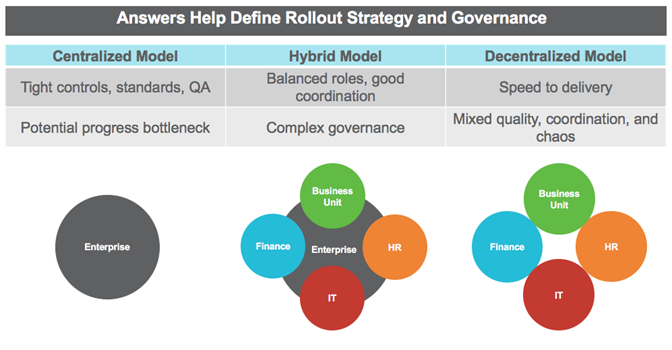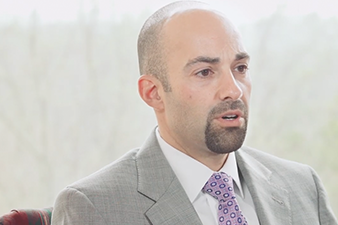
Companies are exploring and implementing technologies, like Robotic Process Automation (RPA), to improve performance across their organizations and extend the value of their business models. In fact, the RPA market is expected to grow to $1.2 billion by 2021 at a compound annual growth of 36 percent. In this white paper, we explore how to design a digital strategy to achieve a sustainable operating model for RPA and other process automation technologies in the face of this significant growth.
Establishing an enterprise-wide RPA Strategy
 Over the last few years, RPA has been one of the most discussed technology trends for process improvement. As mentioned in our previous white paper, “RPA: Innovative Transformation Tool for Shared Services,” RPA is a transformational tool with the ability to lower operating costs, while simultaneously increasing efficiency, scalability, consistency, reliability, security, and transparency. Forrester predicts that in 2018, RPA-based digital workers (i.e., bots) will replace and/or augment 311,000 office and administrative positions, as well as 260,000 sales and related positions. As RPA moves from hype to reality, organizations must develop and deploy a digital strategy to ensure the technology is implemented responsibly and effectively.
Over the last few years, RPA has been one of the most discussed technology trends for process improvement. As mentioned in our previous white paper, “RPA: Innovative Transformation Tool for Shared Services,” RPA is a transformational tool with the ability to lower operating costs, while simultaneously increasing efficiency, scalability, consistency, reliability, security, and transparency. Forrester predicts that in 2018, RPA-based digital workers (i.e., bots) will replace and/or augment 311,000 office and administrative positions, as well as 260,000 sales and related positions. As RPA moves from hype to reality, organizations must develop and deploy a digital strategy to ensure the technology is implemented responsibly and effectively.
Most RPA implementations begin with the deployment of a proof of concept or pilot by a single business unit. While this is a great way to gain traction and foster additional sponsor buy-in, it is only the first step in the RPA journey. As Phil Fersht from Horses for Sources describes, “The reality of moving into an automation arbitrage environment is that you can’t just replicate that work into an even cheaper robotic environment without really figuring out how to do this effectively.”
While there are differing opinions on how to “do this effectively,” you will only succeed by having a clearly defined method to establishing and implementing an enterprise-wide RPA operating model in line with your digital strategy. A model lays the groundwork for future advances in automation by creating a solid foundation, including such critical elements as proper governance, standard processes, and effective communications. Additionally, the planning phase allows you to adjust your digital strategy as your learn more during the process. Below, we discuss four steps to enterprise-wide RPA planning—performing a pilot, defining business objectives, establishing an RPA program, and evaluating the process scope and prioritizing RPA activities.
Four Steps of the Planning Phase to Establish a Scalable, Sustainable Enterprise-wide RPA Operating Model

Perform a Pilot
A basic understanding of RPA is necessary before you build your RPA mission, objectives, and strategies. A good way to understand the capabilities (and challenges) of RPA is to conduct a small, but impactful, pilot or test. This allows you to practice, uncover immediate wins, and share results and lessons learned. A pilot also lets you and other key stakeholders begin planning an approach for implementing RPA that matches the needs of your specific organization and culture.
To start, find a high-volume process that requires significant system data entry, multiple forms that must be manually uploaded, and/or a large group of people required to execute these tasks. Steer clear of processes that involve systems and procedures that change often or include sensitive data.
Once you have selected the process (or processes), you can begin coordinating and educating the people needed to support the pilot. This includes IT security, IT infrastructure, internal controls, human resources, and an internal sponsor or project champion. You don’t need to select your ultimate RPA vendor at this stage. Instead, find a partner who will provide free test licenses, offer online training, and not require a large initial investment. Allow time to test and validate access, develop bots, and run test scenarios, as well as time to standardize and fix processes along the way. Document any lessons learned and answers to the following key questions:
-
How easy was it for IT to set up the test environments and grant system access?
-
How easy was it to find staff capable of developing bots?
-
How much work did your pilot eliminate?
-
What was the capacity of a single bot?
-
How easy was it to move the bot into production?
-
Was the partner helpful in solving problems and transitioning RPA into production?
While these questions seem straightforward, we often find answers alter the original mission, objectives, and overall strategy.
Define Your Business Objectives
The second step in developing a sustainable enterprise-wide RPA operating model is to determine what your organization is trying to accomplish.
What are your goals and business objectives? In other words, what specifically are you trying to optimize by implementing RPA?
Here are five of the most common objectives for our clients, in no particular order. Some clients tackle one at a time, while others undertake multiple, often competing objectives.
-
To mitigate risk and increase compliance by lowering error rates for individual processes
-
To increase the availability of staff for higher-value tasks
-
To reduce processing and execution costs of individual processes
-
To increase productivity and flexibility by aligning processes with work demands
-
To enable 24/7 workflow processing, increasing operational efficiencies
Establish an RPA Program
Once you have your objectives in place, you will need to determine how to sustain your RPA operating model. Therefore, you must also decide the following:
-
What type of governance is required to best sustain your RPA operating model?
-
What group of stakeholders will own and oversee which accountabilities?
-
What group of stakeholders will establish policies and continuously monitor implementation to ensure progress toward the company’s goals?
Moving a pilot into production will quickly reveal the many program responsibilities that need to be put in place, including the following:
-
Who will lead and promote the program on an ongoing basis?
-
Who will purchase and maintain bot licenses?
-
Who will identify and prioritize processes for RPA?
-
Who will develop and maintain the bots?
-
Who will ensure scripting quality and documentation before moving them into production?
-
Who will orchestrate bots so one function’s (e.g., human resources’) bots do not interfere with another function’s (e.g., finance’s) bots?
-
Who will set up and maintain bot infrastructure, including access, laptops, servers, and similar technologies?
Corporate responsibilities will vary depending on your organizational infrastructure. We suggest a program that empowers each business unit to find its own processes and develop its own bots, but relies on common governance to control licenses, ensure quality, and orchestrate bots across the enterprise.
The way you deliver services and technology may point you to a viable answer:
-
How are your back office services organized?
-
How do you deliver business intelligence or reporting services?

Many organizations use an RPA center of expertise (COE) as the heart of their program structure. COEs often have less red tape and bureaucracy than corporate operations, which can create a more relaxed governance approach. However, the COE’s roles must still be clearly defined and documented. The COE leadership team provides best practices, research, support, and training for automation across the enterprise.
Other clients decide to nest these activities under a broader function, such as process improvement, business process optimization, enterprise resource planning, or business process outsourcing.
No matter where you place these items, your RPA program should reside in the area most compatible with your digital strategy. In some cases, this may mean it falls to a specific department, or functional area. For example, if the goal is to lower costs, multiple COEs under each department, such as operations, finance and human resources, may be optimal to enable fast deployment and capture savings for each function. On the other hand, if your goal is to reduce errors, the program may best exist within controls, process improvement, or IT operations to ensure quality, standardized documentation, and cross-functional coordination across departments.
Once you define the program structure, you should outline specific roles and responsibilities for your RPA projects. These may include an RPA sponsor; a steering committee led by a
program manager; a process owner, designer, or subject matter expert (SME); and an automation program lead, developer, and/or controller. You may also have additional supporting roles, such as a database administrator, infrastructure engineer, or IT SME.
Evaluate Process Scope and Prioritize RPA Activities
Depending on your business goals, the types of processes your company will want to automate will most likely change over time.
Early stages of RPA require “quick-win” results to gain stakeholder interest, resources, and funding. During this stage, look for volume. “Rivers” are more interesting than small “creeks.” Big wins also help showcase the major benefits of efficiently automating large volumes of work. If you find the team focusing on a complex process everyone wants fixed, but the task only occurs once a month, take a step back and reevaluate. In this stage, the more transactional and high volume a process, the better.
Later stages of RPA, on the other hand, may focus on more strategic processes. These may include eliminating costly business process optimization work, reducing call center tasks, and enhancing analytical teams. The focus may also turn to relieving high-value resources of mundane work to focus on more valuable services.
ScottMadden utilizes a work activity assessment that isolates activities bots can perform. The assessment identifies who is performing individual activities, as well as the nature, volume, and cost of the work. The results of the work activity assessment allow our clients to eliminate work with repetitive steps and liberate high-value resources to concentrate on higher-value responsibilities.
When prioritizing processes, look for those that include any or all of the following:
-
Forms used for data entry
-
Large groups of employees focused on the same tasks
-
Data pulled or pushed from multiple systems or tools
-
Previously documented logical process steps
Remember, low-value, low-impact processes may be safer, but these small wins will produce small results. Therefore, they will not get the attention of key stakeholders. In addition, these types of processes will not get you the results—resources and budget—you need to propel your RPA program into a sustainable operating model.
Jumpstart Your RPA Journey
As RPA continues to improve business performance and process efficiency worldwide, it’s important to determine whether your company is on the right path. To do so, consider these questions:
-
Do you have an enterprise-wide, three-year plan for RPA?
-
Is your RPA operating model sustainable and aligned with your digital strategy?
-
Do you have the needed buy-in at the right levels of your organization from the right stakeholders?
As more companies integrate RPA technology into their daily business operations, we encourage you to start (or continue) the conversations within your organization.
Stay tuned for our next white paper in this series, which will address implementing your enterprise-wide RPA model, including issues such as workforce and change management, measuring success, and security considerations.
Additional Contributing Author: Jonathan Harb, Todd Kennedy




























































